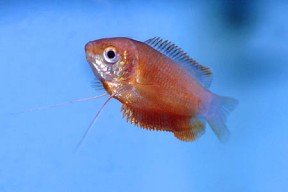Trichogaster labiosa
Thick-lipped Gourami
Classification
Osphronemidae. Subfamily: Luciocephalina
Distribution
Known only from Southern Myanmar.
Habitat
Shady, slow-moving rivers and ponds. It tends to be found in weedy areas with lots of floating vegetation.
Maximum Standard Length
4″ (10 cm).
Aquarium SizeTop ↑
30″ x 12″ x 12″ (74cm x 30cm x 30cm) – 71 litres.
Maintenance
Ideally, keep it in a well-planted tank with a dark substrate. It’s a shy, slow-moving species and will not do well without cover into which it can retreat. Add some floating vegetation to provide further security and mimic its natural waters. Any water flow from filters etc. should be reduced as far as possible.
Water Conditions
Temperature: 72-82°F (22-27°C)
pH: 6.0-7.5
Hardness: 5-15°H
Diet
Undemanding. It will accept the vast majority of foods offered, but is particularly fond of small live and frozen varieties such as bloodworm, daphnia etc.
Behaviour and CompatibilityTop ↑
One of the best gouramis to keep in a community tank, and is actually much more suitable than the popular dwarf gourami, C. lalia. If you buy a group of these as youngsters they will usually live together quite peacefully for life. Other suitable tankmates include danios, rasboras, smaller barbs and loaches. It will also do well with other peaceful anabantoids. Don’t keep it with the closely-related banded or giant gourami, C. fasciata, though. While they are considered distinct species, these two can hybridise freely.
Sexual Dimorphism
The male is the larger, more colourful sex. Mature specimens develop slightly pointed dorsal and anal fins.
Reproduction
Like many Anabantoids, it’s a bubble nest builder. Set up a separate tank for spawning purposes. This should contain shallow water of no more than 6-8″ in depth. Add plenty of floating plants and also some clumps of fine-leaved species to provide cover for the female. Water movement should be avoided. Either use an air-powered sponge filter bubbling gently in a corner, or leave it out altogether. Other parameters are not critical, provided they are within the limits suggested above. The tank should have the tightest-fitting cover you can find (some breeders use clingfilm instead, to ensure no gaps), as the fry need access to a layer of warm, humid air. Without this the development of the labyrinth organ can be impaired.
It’s best to keep the sexes apart in the few weeks leading up to a spawning attempt. This will avoid any unwanted spawns, and will protect the female from the male until she is in condition. Feed them with lots of live and frozen foods during this period. When the female is noticeably round with eggs transfer her to the spawning tank. Add the male a couple of days later. He should begin to intensify in colour almost immediately, and start work on a large bubble nest among the floating plants. This can be several inches in diameter. He will display to the female constantly as he goes. If she is responsive, she will approach the nest to spawn with him.
Spawning occurs under the nest in the typical anabantoid embrace, the male wrapping his body around his mate. As the eggs are released, they start to sink. They are immediately gathered in the male’s mouth and spat into the nest. Several more spawnings occur, with between 500-1000 eggs being produced. Once spawning has ended, the male takes responsibility for guarding and tending the brood. He is less aggressive towards his mate than with other members of the genus, but it’s still best to remove her at this point.
The male then tends to the nest until the eggs hatch. This happens quickly, in around 24-36 hours. He can then also be removed. The fry become free swimming in another 2-3 days. They are very small, and should be fed infusoria or liquid fry food for the first week or so. After this, they are large enough to accept brine shrimp nauplii, microworm and powdered flake. Be sure to keep the tank very well covered throughout the initial stages, so that the labyrinth organ can develop properly.
NotesTop ↑
Despite its ease of keeping and peaceable nature, this species is not particularly popular in the hobby, although it is imported quite regularly. A gold or ‘sunset’ strain exists, in which the barred patterning is replaced by an overall orange/gold colouration. This is not a natural variation, but has been selectively bred for the trade. The female of this form is almost as colourful as the male.
Like others in the suborder Anabantoidei, the species possesses an accessory breathing organ known as the labyrinth organ. So-called due to its maze-like structure, this organ allows the fish to breathe atmospheric air to a certain extent. It is formed by a modification of the first gill arch, and consists of many highly vascularised, folded flaps of skin. The structure of the organ varies in complexity between species, tending to be more well-developed in those inhabiting particularly oxygen-deprived conditions.




May 30th, 2016 at 11:23 am
Hello.
I found several people on the internet maintaining “Trichogaster labiosa” from lake Inlé but have not found a single word about osphronemidae other than Channa in the lake in scientific litterature. But may be i’m bad at searching information about fishes, do you have some?
I have a Lake Inlé biotop tank and a specie of gouramis would be an amazing addition.